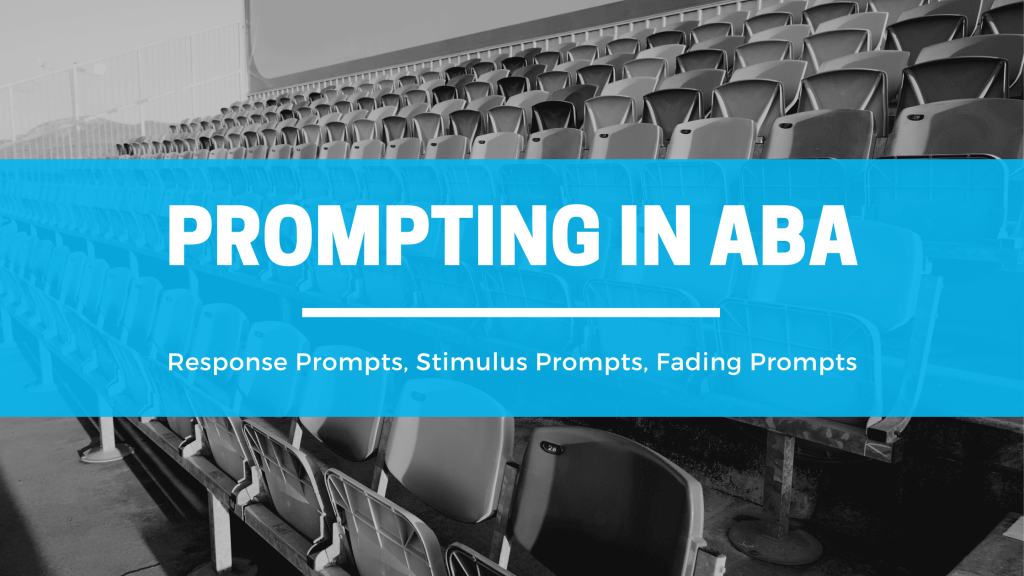How to Prompt in Applied Behavior Analysis

In Applied Behavior Analysis (ABA), there are two types of prompts: stimulus prompts and response prompts. Stimulus prompts are external cues that remind the individual of what they should be doing. For example, a picture of a drink may be a stimulus prompt for an individual to ask for a drink. Response prompts are cues that help the individual to respond correctly. For example, if an individual is asked to name a color, a response prompt might be to say “red” if the color red is presented. Both stimulus and response prompts are important in ABA, as they help the individual to learn new skills and to generalize those skills to new situations. Prompts are antecedent stimuli used to evoke a correct response. Prompts become temporary SDs and are antecedents to behavior.
What are stimulus prompts?
Stimulus prompts in ABA act directly on the antecedent stimulus used during teaching. There are several types of stimulus prompts including movement/gestural prompts, positional prompts, and redundancy prompts. Movement prompts, also known as gestural prompts, include pointing to, tapping, touching, or looking at the correct stimulus. Positional prompts involve moving the correct stimulus to a position that encourages correct responding. This can look like moving the stimulus closer or further away from the learner. Redundancy prompts pair features of the stimulus with the correct choice. You can make the correct stimulus blue while making the other stimuli a different color, for example. You can also change the size or shape of the correct stimulus.
What are response prompts?
Response prompts in applied behavior analysis act directly on the response of the learner. Response prompts include verbal prompts, modeling prompts, and physical prompts. Response prompts are often more intrusive than stimulus prompts. Physical prompting is the most intrusive type of prompt in ABA and can be full, partial, or graduated. Verbal prompts occur frequently in the form of verbal instruction – telling someone what to do – and nonvocal instruction – written words, pictures, and other visual stimuli. Modeling is easy and practical. When RBTs or BCBAs use modeling, they demonstrate the skill exactly as it should be done. Modeling requires that the learner knows how to attend to a model and knows how to imitate a model. Physical prompting has three forms: partial, full, and graduated guidance. Graduated guidance is a type of physical prompting where you only use as much physical prompting as necessary and then fade out the prompt immediately.
Fading the Prompt
Fading the prompt, also known as transferring stimulus control, is often done using a most-to-least strategy or a least-to-most prompting strategy. When using a most-to-least prompting strategy, begin with physical guidance and then slowly reduce the intrusiveness of the prompt. Most to least can be used when a learner needs a lot of help to first learn a new skill. Least-to-most prompting involves giving the opportunity to respond first without a prompt and then slowly introducing the least intrusive prompt possible. Least-to-most can be used when a learner might not need much assistance to learn a skill. Most to least should be the default technology when you don’t know the history. If errors are common, use most-to-least. Least-to-most might be best for quick learners. Graduated guidance and time delay are two more ways to fade prompts. Time delay is considered errorless learning. You present the target and insert a time delay before the prompt is presented allowing the learner a chance to respond. Prompts should be faded to promote maintenance and generalization.
The Importance of Prompts in ABA
A prompt is an external cue that is used to evoke the desired behavior from an individual. Prompts can be in the form of verbal, physical, or visual cues and can act on the response or the stimulus. There are two types of prompts: response prompts which act on the response. For example, hand-over-hand guiding a learner to write their name; and stimulus prompts: these are prompts that act directly on the stimulus. For example, if you are teaching colors, and you are using color cards, you can move the correct color card closer to the learner. Prompts and prompting are essential skills for practitioners in applied behavior analysis. Registered Behavior Technicians (RBT) and Board Certified Behavior Analysts (BCBA) need to know all the different types of prompts and how to use those prompts in order to pass their RBT exam or BCBA Exam.
Watch Prompting: Response, Stimulus, Most-to-Least, Least-to-Most

RBT® Combo - Get Everything!
- Three Practice Exams
- Answer Keys
- Exam Study Guide
- Flashcards
$ 45

RBT® Exam Study Guide
- Terms and Definitions
- Includes Everything on the Exam
- Includes Online and Printable Flashcards
$ 25
For RBT study materials: btexamreview.com
For BCBA study materials: behavioranalyststudy.com

